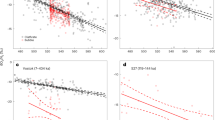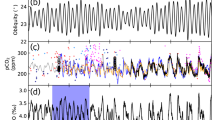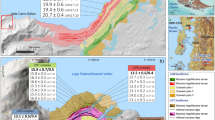Abstract
The change from a glacial to an interglacial climate is paced by variations in Earth’s orbit1. However, the detailed sequence of events that leads to a glacial termination remains controversial. It is particularly unclear whether the northern2,3 or southern4,5,6 hemisphere leads the termination. Here we present a hypothesis for the beginning and continuation of glacial terminations, which relies on the observation that the initial stages of terminations are indistinguishable from the warming stage of events in Antarctica known as Antarctic Isotopic Maxima7, which occur frequently during glacial periods. Such warmings in Antarctica generally begin to reverse with the onset of a warm Dansgaard–Oeschger event in the northern hemisphere7,8. However, in the early stages of a termination, Antarctic warming is not followed by any abrupt warming in the north. We propose that the lack of an Antarctic climate reversal enables southern warming and the associated atmospheric carbon dioxide rise to reach a point at which full deglaciation becomes inevitable. In our view, glacial terminations, in common with other warmings that do not lead to termination, are led from the southern hemisphere, but only specific conditions in the northern hemisphere enable the climate state to complete its shift to interglacial conditions.
This is a preview of subscription content, access via your institution
Access options
Subscribe to this journal
Receive 12 print issues and online access
$259.00 per year
only $21.58 per issue
Buy this article
- Purchase on Springer Link
- Instant access to full article PDF
Prices may be subject to local taxes which are calculated during checkout




Similar content being viewed by others
References
Hays, J. D., Imbrie, J. & Shackleton, N. J. Variations in the earth’s orbit: Pacemaker of the ice ages. Science 194, 1121–1132 (1976).
Alley, R. B., Brook, E. J. & Anandakrishnan, S. A northern lead in the orbital band: North–south phasing of Ice-age events. Quat. Sci. Rev. 21, 431–441 (2002).
Kawamura, K. et al. Northern Hemisphere forcing of climatic cycles over the past 360,000 years implied by accurately dated Antarctic ice cores. Nature 448, 912–916 (2007).
Petit, J. R. et al. Climate and atmospheric history of the past 420,000 years from the Vostok ice core, Antarctica. Nature 399, 429–436 (1999).
Knorr, G. & Lohmann, G. Southern Ocean origin for the resumption of Atlantic thermohaline circulation during deglaciation. Nature 424, 532–536 (2003).
Huybers, P. & Denton, G. Antarctic temperature at orbital timescales controlled by local summer duration. Nature Geosci. 1, 787–792 (2008).
EPICA Community Members.One-to-one hemispheric coupling of millennial polar climate variability during the last glacial. Nature 444, 195–198 (2006).
Blunier, T. & Brook, E. J. Timing of millennial-scale climate change in Antarctica and Greenland during the last glacial period. Science 291, 109–112 (2001).
Jouzel, J. et al. Orbital and millennial Antarctic climate variability over the last 800,000 years. Science 317, 793–796 (2007).
Lisiecki, L. E. & Raymo, M. E. A Pliocene–Pleistocene stack of 57 globally distributed benthic delta O-18 records. Paleoceanography 20, PA1003 (2005).
Siegenthaler, U. et al. Stable carbon cycle-climate relationship during the late Pleistocene. Science 310, 1313–1317 (2005).
Lüthi, D. et al. High-resolution carbon dioxide concentration record 650,000–800,000 years before present. Nature 453, 379–382 (2008).
North Greenland Ice Core Project Members.High-resolution record of Northern Hemisphere climate extending into the last interglacial period. Nature 431, 147–151 (2004).
Loulergue, L. et al. Orbital and millennial-scale features of atmospheric CH4 over the last 800,000 years. Nature 453, 383–386 (2008).
Toggweiler, J. R. Origin of the 100,000-year timescale in Antarctic temperatures and atmospheric CO2 . Paleoceanography 23, PA2211 (2008).
Martrat, B. et al. Four climate cycles of recurring deep and surface water destabilizations on the Iberian margin. Science 317, 502–507 (2007).
Rothlisberger, R. et al. The southern hemisphere at glacial terminations: Insights from the Dome C ice core. Clim. Past 4, 345–356 (2008).
Indermuhle, A. et al. Atmospheric CO2 concentration from 60 to 20 kyr BP from the Taylor Dome ice core, Antarctica. Geophys. Res. Lett. 27, 735–738 (2000).
Wolff, E.W. et al. Southern Ocean sea-ice extent, productivity and iron flux over the past eight glacial cycles. Nature 440, 491–496 (2006).
Fischer, H. et al. Reconstruction of millennial changes in transport, dust emission and regional differences in sea ice coverage using the deep EPICA ice cores from the Atlantic and Indian Ocean sector of Antarctica. Earth Planet. Sci. Lett. 260, 340–354 (2007).
Shackleton, N. J., Hall, M. A. & Vincent, E. Phase relationships between millennial-scale events 64,000–24,000 years ago. Paleoceanography 15, 565–569 (2000).
Stocker, T. F. & Johnsen, S. J. A minimum thermodynamic model for the bipolar seesaw. Paleoceanography 18, 1087 (2003).
Levermann, A., Schewe, J. & Montoya, M. Lack of bipolar see-saw in response to Southern Ocean wind reduction. Geophys. Res. Lett. 34, L12711 (2007).
Parrenin, F. & Paillard, D. Amplitude and phase of glacial cycles from a conceptual model. Earth Planet. Sci. Lett. 214, 243–250 (2003).
Schulz, K. G. & Zeebe, R. E. Pleistocene glacial terminations triggered by synchronous changes in Southern and Northern Hemisphere insolation: The insolation canon hypothesis. Earth Planet. Sci. Lett. 249, 326–336 (2006).
Clark, P. U., Pisias, N. G., Stocker, T. F. & Weaver, A. J. The role of the thermohaline circulation in abrupt climate change. Nature 415, 863–869 (2002).
Mudelsee, M. Ramp function regression: a tool for quantifying climate transitions. Comput. Geosci. 26, 293–307 (2000).
Monnin, E. et al. Atmospheric CO2 concentrations over the last glacial termination. Science 291, 112–114 (2001).
Parrenin, F. et al. The EDC3 chronology for the EPICA Dome C ice core. Clim. Past 3, 485–497 (2007).
Röthlisberger, R. et al. Ice core evidence for the extent of past atmospheric CO2 change due to iron fertilisation. Geophys. Res. Lett. 31, L16207 (2004).
Acknowledgements
This work is a contribution to the European Project for Ice Coring in Antarctica (EPICA), a joint European Science Foundation/European Commission scientific programme, funded by the EU and by national contributions from Belgium, Denmark, France, Germany, Italy, the Netherlands, Norway, Sweden, Switzerland and the United Kingdom. The main logistic support was provided by IPEV and PNRA (at Dome C) and AWI (at Dronning Maud Land).
Author information
Authors and Affiliations
Corresponding author
Supplementary information
Supplementary Fig. S2
Supplementary Information (PDF 272 kb)
Rights and permissions
About this article
Cite this article
Wolff, E., Fischer, H. & Röthlisberger, R. Glacial terminations as southern warmings without northern control. Nature Geosci 2, 206–209 (2009). https://doi.org/10.1038/ngeo442
Received:
Accepted:
Published:
Issue Date:
DOI: https://doi.org/10.1038/ngeo442
This article is cited by
-
Wilkes subglacial basin ice sheet response to Southern Ocean warming during late Pleistocene interglacials
Nature Communications (2022)
-
Asian monsoon intensity coupled to Antarctic climate during Dansgaard–Oeschger 8 and Heinrich 4 glacial intervals
Communications Earth & Environment (2022)
-
A salty deep ocean as a prerequisite for glacial termination
Nature Geoscience (2021)
-
Millennial scale feedbacks determine the shape and rapidity of glacial termination
Nature Communications (2021)
-
Chinese stalagmite paleoclimate researches: A review and perspective
Science China Earth Sciences (2019)



